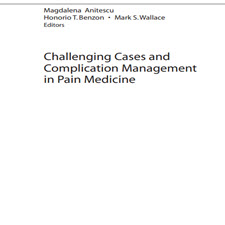Pain Medicine
ABSTRACT
Nociception is the measurable physiological response of specialized sensory receptors (nociceptors) to overt or potential tissue damage and is perceived in the CNS—via the spinothalamic tract, the thalamus, and fnally different areas in the neocortex—as pain. Initially, noxious chemical, mechanical, or thermal stimuli are detected at nerve endings of primary sensory neurons with their soma located in the dorsal root ganglion (DRG) for body sensation, and in the trigeminal ganglion (gasserian ganglion) for face sensation. Specialized receptors (transducers) located at the cell membrane of sensory nerve endings translate the intensity of a given stimulus into action potential frequency, which results in the emission of glutamate and peptides in the respective area in the spinal cord dorsal horn (mostly superfcial laminae I and II with some projections to lamina V). Nociceptors can be divided into different groups by means of their anatomical structure, their characteristic expression of various proteins or the distinct receptors at their terminals, as described below.
INTRODUCTION
Generally, A-δ and C-fbers are the major contributors to physiological nociception, with A-β fbers contributing in pathological states of central sensitization. C-fbers are small in diameter; they are unmyelinated and conduct impulses at the slow rate of 0.5–2 m/s. C fbers have smaller receptive felds than the A-δ nociceptors and mostly terminate in lamina LII of the spinal dorsal horn. Their activation results in a more prolonged sensation of dull and burning pain. Most C-fbers are polymodal receptors and are activated by high-threshold mechanical and various chemical stimuli, as well as by heat (starting at 39–41 °C). These polymodal C-fbers are heavily influenced by both the phenomena of sensitization (enhanced response to a lasting/repetitive stimulus of same intensity) and fatigue (reduced response to a lasting/repetitive stimulus of same intensity).
چکیده
ناسازگاری واکنش فیزیولوژیکی قابل اندازه گیری از گیرنده های حسی ویژه (nociceptors) به آسیب آشکار یا بالقوه بافت است و در CNS از طریق دستگاه اسپیناتالماسی، تالاموس و مناطق مختلف فکری در neocortex مانند درد درک می شود. در ابتدا، محرک های شیمیایی، مکانیکی یا حرارتی خطرناک در انتهای عصبی از نورون های حسی اولیه با سمای خود در گانگلیون ریشه پشتی (DRG) برای حس بدن و در گانگلیون سه گانه (گانگلیون گاکسیری) برای حس چهره شناسایی می شوند. گیرنده های اختصاصی (مبدل) واقع در غشای سلولی انتهای عصب حسینی، شدت محرک داده شده را به فرکانس پتانسیل عمل تبدیل می کنند که منجر به انتشار گلوتامات و پپتید ها در ناحیه مربوطه در شاخۀ پشتی نخاعی می شود (بیشتر لامینا superfaces I و II با برخی از پیش بینی ها به لامینا V). عفونت ادراری را می توان با استفاده از ساختار تشریحی آنها، بیان خاص خود از پروتئین های مختلف و یا گیرنده های متمایز در پایانه های آنها، به صورت زیر توصیف کرد.
مقدمه
به طور کلی، A-δ و C-fbers نقش عمده ای را در بروز بیماری های فیزیولوژیکی ایفا می کنند که A-β-fbers در شرایط آسیب شناسانه حساسیت مرکزی نقش دارند. C-fbers قطر کوچک است؛ آنها unmyelinated و انجام impulses در سرعت آهسته 0.5-2 متر / ثانیه. C fbers داراي فضاهاي جذبي كمتري از Nociceptors A-δ هستند و عمدتا در لامينا LII شاخ پشتي نخاعي ختم مي شوند. فعال شدن آنها منجر به احساس طولانی مدت درد و رنج می شود. اکثر C-fbers دارای گیرنده های چند هسته ای هستند و توسط محرک های مکانیکی و مختلف شیمیایی با شدت بالا (از 39-41 درجه سانتیگراد) فعال می شوند. این پلیموادال C-fbers به شدت تحت تاثیر هر دو پدیده حساسیت (افزایش پاسخ به یک محرک ماندگار / تکراری از همان شدت) و خستگی (کاهش پاسخ به یک محرک ماندگار / تکراری از همان شدت).
Year: 2016
Publisher: SPRINGER
By : R. Jason Yong, Michael Nguyen, Ehren Nelson, Richard D. Urman
File Information: English Language/ 540 Page / size: 14.34 MB
سال : 1395
ناشر : SPRINGER
کاری از : R. Jason یونگ، مایکل نگوین، اهرن نلسون، ریچارد دی. اورمن
اطلاعات فایل : زبان انگلیسی / 540 صفحه / حجم : MB 14.34


![Pain.Medicine.An.Essential.Review.[taliem.ir]](https://taliem.ir/wp-content/uploads/Pain.Medicine.An_.Essential.Review.taliem.ir_.jpg)


![Oncologic.Imaging.Spine.and.Spinal.[taliem.ir]](https://taliem.ir/wp-content/uploads/Oncologic.Imaging.Spine_.and_.Spinal.taliem.ir_-150x150.jpg)
![Mycobacterial.Skin.Infections.[taliem.ir]](https://taliem.ir/wp-content/uploads/Mycobacterial.Skin_.Infections.taliem.ir_-150x150.jpg)
دیدگاه خود را ثبت کنید
تمایل دارید در گفتگو شرکت کنید؟نظری بدهید!